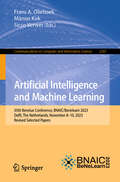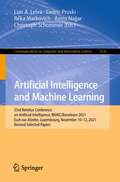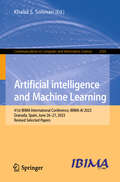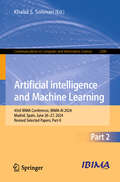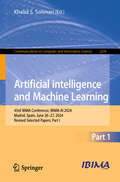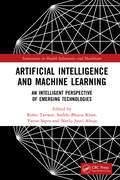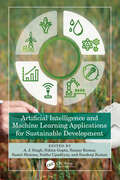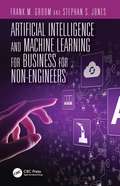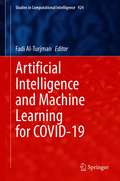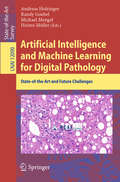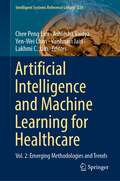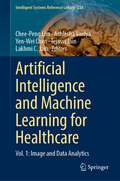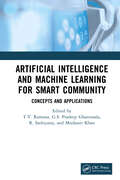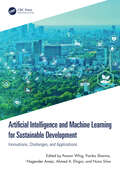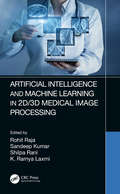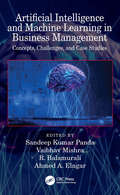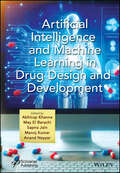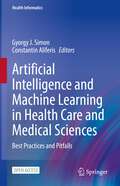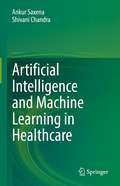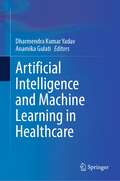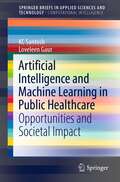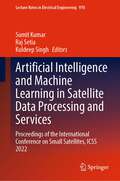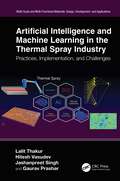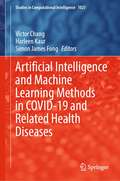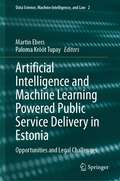- Table View
- List View
Artificial Intelligence and Machine Learning: 35th Benelux Conference, BNAIC/Benelearn 2023, Delft, The Netherlands, November 8–10, 2023, Revised Selected Papers (Communications in Computer and Information Science #2187)
by Frans A. Oliehoek Manon Kok Sicco VerwerThis book constitutes the refereed proceedings of the 35th Benelux Conference on Artificial Intelligence and Machine Learning, BNAIC/Benelearn 2023, held in Delft, The Netherlands, during November 8–10, 2023. The 14 papers included in these proceedings were carefully reviewed and selected from 47 submissions. These papers focus on various aspects of Artificial Intelligence and Machine learning, including Natural Language Processing and Reinforcement Learning, and their applications.
Artificial Intelligence and Machine Learning: 33rd Benelux Conference on Artificial Intelligence, BNAIC/Benelearn 2021, Esch-sur-Alzette, Luxembourg, November 10–12, 2021, Revised Selected Papers (Communications in Computer and Information Science #1530)
by Cédric Pruski Amro Najjar Luis A. Leiva Réka Markovich Christoph SchommerThis book contains a selection of the best papers of the 33rd Benelux Conference on Artificial Intelligence, BNAIC/ BENELEARN 2021, held in Esch-sur-Alzette, Luxembourg, in November 2021. The 14 papers presented in this volume were carefully reviewed and selected from 46 regular submissions. They address various aspects of artificial intelligence such as natural language processing, agent technology, game theory, problem solving, machine learning, human-agent interaction, AI and education, and data analysis.
Artificial intelligence and Machine Learning: 41st IBIMA International Conference, IBIMA-AI 2023, Granada, Spain, June 26–27, 2023, Revised Selected Papers (Communications in Computer and Information Science #2101)
by Khalid S. SolimanThis book constitutes the revised selected papers of the 41st IBIMA International Conference on Artificial intelligence and Computer Science, IBIMA-AI 2023, which took place in Granada, Spain during June 26-27, 2023. The 30 full papers and 8 short papers included in this volume were carefully reviewed and selected from 58 submissions. The book showcases a diverse array of research papers spanning various disciplines within the realm of Artificial Intelligence, Machine Learning, Information Systems, Communications Technologies, Software Engineering, and Security and Privacy.
Artificial Intelligence and Machine Learning: 43rd IBIMA Conference, IBIMA-AI 2024, Madrid, Spain, June 26–27, 2024, Revised Selected Papers, Part-II (Communications in Computer and Information Science #2300)
by Khalid S. SolimanThe two-volume proceedings set CCIS 2299 and 2300, constitutes the refereed proceedings of the 43rd IBIMA Conference on Artificial intelligence and Machine Learning, IBIMA-AI 2024, held in Madrid, Spain, in June 26–27, 2024. The 44 full papers and 18 short papers included in this book were carefully reviewed and selected from 119 submissions. They were organized in topical sections as follows: Part I:Artificial Intelligence and Machine Learning; Information Systems and Communications Technologies. Part II: Artificial Intelligence and Machine Learning ; Software Engineering; Computer Security and Privacy.
Artificial Intelligence and Machine Learning: 43rd IBIMA Conference, IBIMA-AI 2024, Madrid, Spain, June 26–27, 2024, Revised Selected Papers, Part-I (Communications in Computer and Information Science #2299)
by Khalid S. SolimanThe two-volume proceedings set CCIS 2299 and 2300, constitutes the refereed proceedings of the 43rd IBIMA Conference on Artificial intelligence and Machine Learning, IBIMA-AI 2024, held in Madrid, Spain, in June 26–27, 2024. The 44 full papers and 18 short papers included in this book were carefully reviewed and selected from 119 submissions. They were organized in topical sections as follows: Part I: Artificial Intelligence and Machine Learning; Information Systems and Communications Technologies. Part II: Artificial Intelligence and Machine Learning ; Software Engineering; Computer Security and Privacy.
Artificial Intelligence and Machine Learning: An Intelligent Perspective of Emerging Technologies (Innovations in Health Informatics and Healthcare)
by Rohit Tanwar Surbhi Bhatia Khan Varun Sapra Neelu Jyoti AhujaThis book focuses on artificial intelligence (AI) and machine learning (ML) technologies and how they are progressively being incorporated into a wide range of products, including consumer gadgets, "smart" personal assistants, cutting-edge medical diagnostic systems, and quantum computing systems. This concise reference book offers a broad overview of the most important trends and discusses how these trends and technologies are being created and employed in the applications in which they are being used. Artificial Intelligence and Machine Learning: An Intelligent Perspective of Emerging Technologies offers a broad package involving the incubation of AI and ML with various emerging technologies such as Internet of Things (IoT), healthcare, smart cities, robotics, and more. The book discusses various data collection and data transformation techniques and also maps the legal and ethical issues of data-driven e-healthcare systems while covering possible ways to resolve them. The book explores different techniques on how AI can be used to create better virtual reality experiences and deals with the techniques and possible ways to merge the power of AI and IoT to create smart home appliances. With contributions from experts in the field, this reference book is useful to healthcare professionals, researchers, and students of industrial engineering, systems engineering, biomedical, computer science, electronics, and communications engineering.
Artificial Intelligence and Machine Learning Applications for Sustainable Development
by A. J. Singh, Nikita Gupta, Sanjay Kumar, Sumit Sharma, Subho Upadhyay, and Sandeep KumarThe book highlights how technologies including artificial intelligence and machine learning are transforming renewable energy technologies and enabling the development of new solutions. It further discusses how smart technologies are employed to optimize energy production and storage, enhance energy efficiency, and improve the overall sustainability of energy systems.This book: Discusses artificial intelligence-based techniques, namely, neural networks, fuzzy expert systems, optimization techniques, and operational research Showcases the importance of artificial intelligence and machine learning in the energy market, demand analysis, and forecasting of renewable energy applications Illustrates strategies for sustainable development using artificial intelligence and machine learning applications Presents applications of artificial intelligence in the domain of electronics transformation and development, smart cities, and renewable energy utilization Highlights the role of artificial intelligence in solving problems such as image and signal processing, smart weather monitoring, smart farming, and distributed energy sources It is primarily written for senior undergraduates, graduate students, and academic researchers in diverse fields, including electrical, electronics and communications, energy, and environmental engineering.
Artificial Intelligence and Machine Learning for Business for Non-Engineers (Technology for Non-Engineers)
by Stephan S. Jones Frank M. GroomThe next big area within the information and communication technology field is Artificial Intelligence (AI). The industry is moving to automate networks, cloud-based systems (e.g., Salesforce), databases (e.g., Oracle), AWS machine learning (e.g., Amazon Lex), and creating infrastructure that has the ability to adapt in real-time to changes and learn what to anticipate in the future. It is an area of technology that is coming faster and penetrating more areas of business than any other in our history. AI will be used from the C-suite to the distribution warehouse floor. Replete with case studies, this book provides a working knowledge of AI’s current and future capabilities and the impact it will have on every business. It covers everything from healthcare to warehousing, banking, finance and education. It is essential reading for anyone involved in industry.
Artificial Intelligence and Machine Learning for COVID-19 (Studies in Computational Intelligence #924)
by Fadi Al-TurjmanThis book is dedicated to addressing the major challenges in fighting COVID-19 using artificial intelligence (AI) and machine learning (ML) – from cost and complexity to availability and accuracy. The aim of this book is to focus on both the design and implementation of AI-based approaches in proposed COVID-19 solutions that are enabled and supported by sensor networks, cloud computing, and 5G and beyond. This book presents research that contributes to the application of ML techniques to the problem of computer communication-assisted diagnosis of COVID-19 and similar diseases. The authors present the latest theoretical developments, real-world applications, and future perspectives on this topic. This book brings together a broad multidisciplinary community, aiming to integrate ideas, theories, models, and techniques from across different disciplines on intelligent solutions/systems, and to inform how cognitive systems in Next Generation Networks (NGN) should be designed, developed, and evaluated while exchanging and processing critical health information. Targeted readers are from varying disciplines who are interested in implementing the smart planet/environments vision via wireless/wired enabling technologies.
Artificial Intelligence and Machine Learning for Digital Pathology: State-of-the-Art and Future Challenges (Lecture Notes in Computer Science #12090)
by Andreas Holzinger Randy Goebel Michael Mengel Heimo MüllerData driven Artificial Intelligence (AI) and Machine Learning (ML) in digital pathology, radiology, and dermatology is very promising. In specific cases, for example, Deep Learning (DL), even exceeding human performance. However, in the context of medicine it is important for a human expert to verify the outcome. Consequently, there is a need for transparency and re-traceability of state-of-the-art solutions to make them usable for ethical responsible medical decision support. Moreover, big data is required for training, covering a wide spectrum of a variety of human diseases in different organ systems. These data sets must meet top-quality and regulatory criteria and must be well annotated for ML at patient-, sample-, and image-level. Here biobanks play a central and future role in providing large collections of high-quality, well-annotated samples and data. The main challenges are finding biobanks containing ‘‘fit-for-purpose’’ samples, providing quality related meta-data, gaining access to standardized medical data and annotations, and mass scanning of whole slides including efficient data management solutions.
Artificial Intelligence and Machine Learning for Healthcare: Vol. 2: Emerging Methodologies and Trends (Intelligent Systems Reference Library #229)
by Chee Peng Lim Ashlesha Vaidya Yen-Wei Chen Vaishnavi Jain Lakhmi C. JainIn line with advances in digital and computing systems, artificial intelligence (AI) and machine learning (ML) technologies have transformed many aspects of medical and healthcare services, delivering tangible benefits to patents and the general public. This book is a sequel of the edition on “Artificial Intelligence and Machine Learning for Healthcare”. The first volume is focused on utilization of AI and ML for image and data analytics in the medical and healthcare domains. In this second volume, emerging methodologies and future trends in AI and ML for advancing medical treatments and healthcare services are presented. The selected studies in this book provide readers a glimpse on current progresses in AI and ML for undertaking a variety of healthcare-related tasks. The advances in AI and ML technologies for future healthcare are also discussed, shedding light on the potential of AI and ML to realize the next-generation medical treatments and healthcare services for the betterment of our global society.
Artificial Intelligence and Machine Learning for Healthcare: Vol. 1: Image and Data Analytics (Intelligent Systems Reference Library #228)
by Chee-Peng Lim Ashlesha Vaidya Yen-Wei Chen Tejasvi Jain Lakhmi C. JainArtificial intelligence (AI) and machine learning (ML) have transformed many standard and conventional methods in undertaking health and well-being issues of humans. AL/ML-based systems and tools play a critical role in this digital and big data era to address a variety of medical and healthcare problems, improving treatments and quality of care for patients. This edition on AI and ML for healthcare consists of two volumes. The first presents selected AI and ML studies on medical imaging and healthcare data analytics, while the second unveils emerging methodologies and trends in AI and ML for delivering better medical treatments and healthcare services in the future.In this first volume, progresses in AI and ML technologies for medical image, video, and signal processing as well as health information and data analytics are presented. These selected studies offer readers theoretical and practical knowledge and ideas pertaining to recent advances in AI and ML for effective and efficient image and data analytics, leading to state-of-the-art AI and ML technologies for advancing the healthcare sector.
Artificial Intelligence and Machine Learning for Smart Community: Concepts and Applications
by T. V. Ramana G. S. Pradeep Ghantasala R. Sathiyaraj Mudassir KhanIntelligent systems are technologically advanced machines that perceive and respond to the world around them. Artificial Intelligence and Machine Learning for Smart Community: Concepts and Applications presents the evolution, challenges, and limitations of the application of machine learning and artificial intelligence to intelligent systems and smart communities. Covers the core and fundamental aspects of artificial intelligence, machine learning, and computational algorithms in smart intelligent systems Discusses the integration of artificial intelligence with machine learning using mathematical modeling Elaborates concepts like supervised and unsupervised learning, and machine learning algorithms, such as linear regression, logistic regression, random forest, and performance evaluation matrices Introduces modern algorithms such as convolutional neural networks and support vector machines Presents case studies on smart healthcare, smart traffic management, smart buildings, autonomous vehicles, smart education, modern community, and smart machines Artificial Intelligence and Machine Learning for Smart Community: Concepts and Applications is primarily written for graduate students and academic researchers working in the fields of computer science and engineering, electrical engineering, and information technology. Seasonal Blurb: This reference text presents the most recent and advanced research on the application of artificial intelligence and machine learning on intelligent systems. It will discuss important topics such as business intelligence, reinforcement learning, supervised learning, and unsupervised learning in a comprehensive manner.
Artificial Intelligence and Machine Learning for Sustainable Development: Innovations, Challenges, and Applications
by Pawan Whig Pavika Sharma Nagender Aneja Ahmed A. Elngar Nuno SilvaArtificial Intelligence and Machine Learning for Sustainable Development is a comprehensive exploration of how artificial intelligence (AI) and machine learning (ML) technologies are revolutionizing the field of sustainable development.The book examines cutting-edge innovations, practical applications, and potential challenges in harnessing AI and ML to address global sustainability issues. It offers insights into how these technologies can optimize resource management, improve environmental monitoring, enhance decision-making processes, and promote equitable, eco-friendly solutions. This book would be of special interest to researchers, policymakers, and practitioners seeking to leverage cutting-edge technology for a more sustainable future.
Artificial Intelligence and Machine Learning in 2D/3D Medical Image Processing
by Rohit Raja Sandeep Kumar Shilpa Rani K. Ramya LaxmiDigital images have several benefits, such as faster and inexpensive processing cost, easy storage and communication, immediate quality assessment, multiple copying while preserving quality, swift and economical reproduction, and adaptable manipulation. Digital medical images play a vital role in everyday life. Medical imaging is the process of producing visible images of inner structures of the body for scientific and medical study and treatment as well as a view of the function of interior tissues. This process pursues disorder identification and management. Medical imaging in 2D and 3D includes many techniques and operations such as image gaining, storage, presentation, and communication. The 2D and 3D images can be processed in multiple dimensions. Depending on the requirement of a specific problem, one must identify various features of 2D or 3D images while applying suitable algorithms. These image processing techniques began in the 1960s and were used in such fields as space, clinical purposes, the arts, and television image improvement. In the 1970s, with the development of computer systems, the cost of image processing was reduced and processes became faster. In the 2000s, image processing became quicker, inexpensive, and simpler. In the 2020s, image processing has become a more accurate, more efficient, and self-learning technology. This book highlights the framework of the robust and novel methods for medical image processing techniques in 2D and 3D. The chapters explore existing and emerging image challenges and opportunities in the medical field using various medical image processing techniques. The book discusses real-time applications for artificial intelligence and machine learning in medical image processing. The authors also discuss implementation strategies and future research directions for the design and application requirements of these systems. This book will benefit researchers in the medical image processing field as well as those looking to promote the mutual understanding of researchers within different disciplines that incorporate AI and machine learning. FEATURES Highlights the framework of robust and novel methods for medical image processing techniques Discusses implementation strategies and future research directions for the design and application requirements of medical imaging Examines real-time application needs Explores existing and emerging image challenges and opportunities in the medical field
Artificial Intelligence and Machine Learning in Business Management: Concepts, Challenges, and Case Studies
by Sandeep Kumar Panda Vaibhav Mishra R. Balamurali Ahmed A. ElngarArtificial Intelligence and Machine Learning in Business Management The focus of this book is to introduce artificial intelligence (AI) and machine learning (ML) technologies into the context of business management. The book gives insights into the implementation and impact of AI and ML to business leaders, managers, technology developers, and implementers. With the maturing use of AI or ML in the field of business intelligence, this book examines several projects with innovative uses of AI beyond data organization and access. It follows the Predictive Modeling Toolkit for providing new insight on how to use improved AI tools in the field of business. It explores cultural heritage values and risk assessments for mitigation and conservation and discusses on-shore and off-shore technological capabilities with spatial tools for addressing marketing and retail strategies, and insurance and healthcare systems. Taking a multidisciplinary approach for using AI, this book provides a single comprehensive reference resource for undergraduate, graduate, business professionals, and related disciplines.
Artificial Intelligence and Machine Learning in Drug Design and Development (Fintech in a Sustainable Digital Society)
by Manoj Kumar Anand Nayyar Abhirup Khanna May El Barachi Sapna JainThe book is a comprehensive guide that explores the use of artificial intelligence and machine learning in drug discovery and development covering a range of topics, including the use of molecular modeling, docking, identifying targets, selecting compounds, and optimizing drugs. The intersection of Artificial Intelligence (AI) and Machine Learning (ML) within the field of drug design and development represents a pivotal moment in the history of healthcare and pharmaceuticals. The remarkable synergy between cutting-edge technology and the life sciences has ushered in a new era of possibilities, offering unprecedented opportunities, formidable challenges, and a tantalizing glimpse into the future of medicine. AI can be applied to all the key areas of the pharmaceutical industry, such as drug discovery and development, drug repurposing, and improving productivity within a short period. Contemporary methods have shown promising results in facilitating the discovery of drugs to target different diseases. Moreover, AI helps in predicting the efficacy and safety of molecules and gives researchers a much broader chemical pallet for the selection of the best molecules for drug testing and delivery. In this context, drug repurposing is another important topic where AI can have a substantial impact. With the vast amount of clinical and pharmaceutical data available to date, AI algorithms find suitable drugs that can be repurposed for alternative use in medicine. This book is a comprehensive exploration of this dynamic and rapidly evolving field. In an era where precision and efficiency are paramount in drug discovery, AI and ML have emerged as transformative tools, reshaping the way we identify, design, and develop pharmaceuticals. This book is a testament to the profound impact these technologies have had and will continue to have on the pharmaceutical industry, healthcare, and ultimately, patient well-being. The editors of this volume have assembled a distinguished group of experts, researchers, and thought leaders from both the AI, ML, and pharmaceutical domains. Their collective knowledge and insights illuminate the multifaceted landscape of AI and ML in drug design and development, offering a roadmap for navigating its complexities and harnessing its potential. In each section, readers will find a rich tapestry of knowledge, case studies, and expert opinions, providing a 360-degree view of AI and ML’s role in drug design and development. Whether you are a researcher, scientist, industry professional, policymaker, or simply curious about the future of medicine, this book offers 19 state-of-the-art chapters providing valuable insights and a compass to navigate the exciting journey ahead. Audience The book is a valuable resource for a wide range of professionals in the pharmaceutical and allied industries including researchers, scientists, engineers, and laboratory workers in the field of drug discovery and development, who want to learn about the latest techniques in machine learning and AI, as well as information technology professionals who are interested in the application of machine learning and artificial intelligence in drug development.
Artificial Intelligence and Machine Learning in Health Care and Medical Sciences: Best Practices and Pitfalls (Health Informatics)
by Gyorgy J. Simon Constantin AliferisThis open access book provides a detailed review of the latest methods and applications of artificial intelligence (AI) and machine learning (ML) in medicine. With chapters focusing on enabling the reader to develop a thorough understanding of the key concepts in these subject areas along with a range of methods and resulting models that can be utilized to solve healthcare problems, the use of causal and predictive models are comprehensively discussed. Care is taken to systematically describe the concepts to facilitate the reader in developing a thorough conceptual understanding of how different methods and resulting models function and how these relate to their applicability to various issues in health care and medical sciences. Guidance is also given on how to avoid pitfalls that can be encountered on a day-to-day basis and stratify potential clinical risks. Artificial Intelligence and Machine Learning in Health Care and Medical Sciences: Best Practices and Pitfallsis a comprehensive guide to how AI and ML techniques can best be applied in health care. The emphasis placed on how to avoid a variety of pitfalls that can be encountered makes it an indispensable guide for all medical informatics professionals and physicians who utilize these methodologies on a day-to-day basis. Furthermore, this work will be of significant interest to health data scientists, administrators and to students in the health sciences seeking an up-to-date resource on the topic.
Artificial Intelligence and Machine Learning in Healthcare
by Ankur Saxena Shivani ChandraThis book reviews the application of artificial intelligence and machine learning in healthcare. It discusses integrating the principles of computer science, life science, and statistics incorporated into statistical models using existing data, discovering patterns in data to extract the information, and predicting the changes and diseases based on this data and models. The initial chapters of the book cover the practical applications of artificial intelligence for disease prognosis & management. Further, the role of artificial intelligence and machine learning is discussed with reference to specific diseases like diabetes mellitus, cancer, mycobacterium tuberculosis, and Covid-19. The chapters provide working examples on how different types of healthcare data can be used to develop models and predict diseases using machine learning and artificial intelligence. The book also touches upon precision medicine, personalized medicine, and transfer learning, with the real examples. Further, it also discusses the use of machine learning and artificial intelligence for visualization, prediction, detection, and diagnosis of Covid -19. This book is a valuable source of information for programmers, healthcare professionals, and researchers interested in understanding the applications of artificial intelligence and machine learning in healthcare.
Artificial Intelligence and Machine Learning in Healthcare
by Dharmendra Kumar Yadav Anamika GulatiThis book is about the use of artificial intelligence (AI) and machine learning in healthcare. AI and related technologies are increasingly prevalent in business and society and are beginning to be applied to healthcare. These technologies have the potential to transform many aspects of patient care, as well as administrative processes within provider, payer, and pharmaceutical organizations. There are already a number of research studies suggesting that AI can perform as well as or better than humans at key healthcare tasks, such as diagnosing disease. Today, algorithms are already outperforming radiologists at spotting malignant tumors and guiding researchers in how to construct cohorts for costly clinical trials. However, for a variety of reasons, the authors believe that it will be many years before AI replaces humans for broad medical process domains. Through this book, the authors describe both the potential that AI offers to automate aspects of care and some of the barriers to rapid implementation of AI in healthcare.
Artificial Intelligence and Machine Learning in Public Healthcare: Opportunities and Societal Impact (SpringerBriefs in Applied Sciences and Technology)
by KC Santosh Loveleen GaurThis book discusses and evaluates AI and machine learning (ML) algorithms in dealing with challenges that are primarily related to public health. It also helps find ways in which we can measure possible consequences and societal impacts by taking the following factors into account: open public health issues and common AI solutions (with multiple case studies, such as TB and SARS: COVID-19), AI in sustainable health care, AI in precision medicine and data privacy issues. Public health requires special attention as it drives economy and education system. COVID-19 is an example—a truly infectious disease outbreak. The vision of WHO is to create public health services that can deal with abovementioned crucial challenges by focusing on the following elements: health protection, disease prevention and health promotion. For these issues, in the big data analytics era, AI and ML tools/techniques have potential to improve public health (e.g., existing healthcare solutions and wellness services). In other words, they have proved to be valuable tools not only to analyze/diagnose pathology but also to accelerate decision-making procedure especially when we consider resource-constrained regions.
Artificial Intelligence and Machine Learning in Satellite Data Processing and Services: Proceedings of the International Conference on Small Satellites, ICSS 2022 (Lecture Notes in Electrical Engineering #970)
by Sumit Kumar Kuldeep Singh Raj SetiaThis book, Artificial Intelligence and Machine Learning in Satellite: Data Processing and Services, presents the selected proceedings of the International Conference on Small Satellites (ICSS 2022) that aims to provide an opportunity for academicians, scientists, researchers, and industry experts, engaged in teaching, research, and development on satellite data processing and its services by employing advanced artificial intelligence-based machine learning techniques. This book covers the application of artificial intelligence and machine learning techniques in various domains of earth observations like natural resources and environmental management, water resources, urban and rural development, climate change, and other contemporary subjects. The book will surely be a valuable asset for beginners, researchers, and professionals working in satellite data processing and services using artificial intelligence and machine learning approaches.
Artificial Intelligence and Machine Learning in the Thermal Spray Industry: Practices, Implementation, and Challenges (Multi-Scale and Multi-Functional Materials)
by Lalit Thakur Hitesh Vasudev Jashanpreet Singh Gaurav PrasharThis book details the emerging area of the induction of expert systems in thermal spray technology, replacing traditional parametric optimization methods like numerical modeling and simulation. It promotes, enlightens, and hastens the digital transformation of the surface engineering industry by discussing the contribution of expert systems like Machine Learning (ML) and Artificial Intelligence (AI) toward achieving durable Thermal Spray (TS) coatings. Artificial Intelligence and Machine Learning in the Thermal Spray Industry: Practices, Implementation, and Challenges highlights how AI and ML techniques are used in the TS industry. It sheds light on AI’s versatility, revealing its applicability in solving problems related to conventional simulation and numeric modeling techniques. This book combines automated technologies with expert machines to show several advantages, including decreased error and greater accuracy in judgment, and prediction, enhanced efficiency, reduced time consumption, and lower costs. Specific barriers preventing AI’s successful implementation in the TS industry are also discussed. This book also looks at how training and validating more models with microstructural features of deposited coating will be the center point to grooming this technology in the future. Lastly, this book thoroughly analyzes the digital technologies available for modeling and achieving high-performance coatings, including giving AI-related models like Artificial Neural Networks (ANN) and Convolutional Neural Networks (CNN) more attention. This reference book is directed toward professors, students, practitioners, and researchers of higher education institutions working in the fields that deal with the application of AI and ML technology.
Artificial Intelligence and Machine Learning Methods in COVID-19 and Related Health Diseases (Studies in Computational Intelligence #1023)
by Victor Chang Harleen Kaur Simon James FongThis Springer book provides a perfect platform to submit chapters that discuss the prospective developments and innovative ideas in artificial intelligence and machine learning techniques in the diagnosis of COVID-19. COVID-19 is a huge challenge to humanity and the medical sciences. So far as of today, we have been unable to find a medical solution (Vaccine). However, globally, we are still managing the use of technology for our work, communications, analytics, and predictions with the use of advancement in data science, communication technologies (5G & Internet), and AI. Therefore, we might be able to continue and live safely with the use of research in advancements in data science, AI, machine learning, mobile apps, etc., until we can find a medical solution such as a vaccine. We have selected eleven chapters after the vigorous review process. Each chapter has demonstrated the research contributions and research novelty. Each group of authors must fulfill strict requirements.
Artificial Intelligence and Machine Learning Powered Public Service Delivery in Estonia: Opportunities and Legal Challenges (Data Science, Machine Intelligence, and Law #2)
by Martin Ebers Paloma Krõõt TupayThis book gives a comprehensive overview of the state of Artificial Intelligence (AI), especially machine learning (ML) applications in public service delivery in Estonia, discussing the manifold ethical and legal issues that arise under both European and Estonian law. Final conclusions and recommendations set out and analyze various policy options for the public sector, taking into account recent developments at the European level – such as the AIA proposal – as well as the experience of countries that have issued principles and guidelines or even laws for the use of ML in the public sector. “For two reasons, this study is relevant not only for an audience which is interested in Estonian administrative law. First, the authors base their legal analysis primarily on EU law and provide a state of the art-analysis of the relevant secondary legislation. This makes the book a reference text for the European debate on public sector AI governance. Second, this study is part of a larger research project in which four specific use cases of public sector AI have been developed and tested. The practical insights gained in these projects have provided the authors with an excellent understanding of the opportunities and risks of the technology, which distinguishes this legal analysis from similar enterprises.” Excerpt from the foreword by Professor Thomas Wischmeyer (University of Bielefeld)
